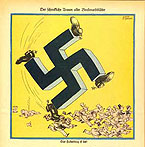Schrift: größer/kleiner
Inhaltsverzeichnis
Sie sind hier: WirRheinländer > english version > Weimar Republic, Nazi Dictatorship and Second World War (1919 - 1945) > 1933-1945
Weimar Republic, Nazi Dictatorship and Second World War (1919 - 1945)
1933 - 1945
The "Third Reich"
The horrors of National Socialism (Nazism) between the seizure of power on 31st January 1933 and the end of the Second World War in Europe on 8th May 1945 left deep scars in the Rhineland and in Westphalia.
The ideology and aims of National Socialism were consistently oriented towards forcing the regional Länder into line with the central government, as well as creating hierarchical and monolithic structures in politics, society and also the economy.
At no other time in history were the typical characteristics and profiles of both regions so reduced and repressed as during those years. Although the election of 1933 showed that it was certainly not a majority of Rhinelanders, and still far fewer Westphalians who wanted a National Socialist dictatorship, despite an election result almost 8 percent below the national average for the NSDAP, over 35% did vote for the National Socialists. There was no great rebellion against the removal of constitutional structures. The persecution of political dissidents, the barbaric disdain for human rights and dignity followed a similar course to the rest of Germany.

The atrocities of 9th/10th November 1938 hardly spared any Jewish establishments. Very few synagogues were not destroyed; those which had already found another owner beforehand, because life as a Jew had expired or become impossible. The persecution of the Jews, the theft of their property and at the end, their almost total abduction and murder belong to the darkest chapters in the history of the Rhineland and Westphalia.
The Ruhr region, the special economic power of the Rhineland and its strategic importance made today's North Rhine-Westphalia the centre of the Second World War at the beginning. From here the blitzkrieg against neutral neighbours was started, here was the location of the key industries for the war effort and of course for weapons production. From 1942 a considerable part of the aerial warfare of the Allies was concentrated on the Ruhr region, the largest towns and industrial areas at the Rhine and Ruhr. In 1944 Aachen was the first German city to be captured by the Allies, and terrible fighting and battles took place here towards the end of the war, such as the battle of Hürtgenwald, which caused inestimable devastation and destruction.


